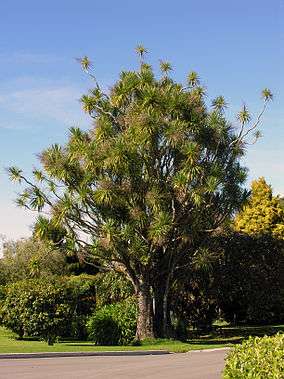Bushy Park (New Zealand)
Bushy Park is a forest located on the west coast of the North Island of New Zealand, at 791 Rangitatau East Road, 8 kilometres (5.0 mi) from Kai Iwi, Whanganui, Manawatū-Whanganui region. It features an Edwardian-era homestead, Bushy Park Homestead, which is a Category I heritage building registered with Heritage New Zealand, a predator-free native bird sanctuary, and a virgin rainforest.[1] It measures approximately 100 hectares (250 acres),[2] and is characterized as a "lowland remnant of rata-podocarp taka-puketea [sic] rainforest".[3] According to Forest & Bird, Bushy Park is considered to be amongst the 25 best restoration ecology projects in Australia and New Zealand.[4]
| Bushy Park Forest Reserve | |
|---|---|
 Cabbage tree in Bushy Park | |
| Location | 791 Rangitatau East Road, Manawatū-Whanganui region, North Island, New Zealand |
| Nearest city | Whanganui |
| Area | 100 hectares (250 acres) |
| Established | 1962 |
| Governing body | Bushy Park Homestead and Forest Trust |
| website | |
History
The 22-room Edwardian homestead, designed by Charles Tilleard Natusch, includes a 109 feet (33 m) long, 6 feet (1.8 m)-wide hall that runs the length of the residence, as well as wood panelling, carved mantels, and art deco lights.[5] Built by Russell and Bignell in 1906 at a cost of £4,566 for G. Frank Moore, a cattle and racehorse breeder, the residence and park were given to the Royal Forest and Bird Protection Society of New Zealand by Moore in 1962.[6]
The homestead, bird sanctuary, and rain forest have been managed by Bushy Park Homestead and Forest Trust[7] since 1994.[8] The Bushy Park Festival, an annual event on the Sunday of Wellington Anniversary weekend, is the major fundraising event for the trust.[9]
During the period of 2004 to 2005, a 4.8 kilometres (3.0 mi) pest-exclusion fence was built around the park and two aerial drops of rodent bait occurred later in 2005.[6] The opening of Bushy Park’s kiwi creche, also in 2005, was marked by the arrival of a female kiwi chick from the Waimarino Forest.[3]
Flora and fauna
A network of ten[4] forest paths traverse the forest reserve that includes mahoe, mamaku, pukatea, rātā, and rimu along with colonies of ferns and mosses.[5] A feature of the reserve is a large northern rātā Metrosideros robusta named Ratanui ("Big Rata"). It is estimated to be between 500 and 1000 years old. It is 43 metres (141 ft) in height while its girth exceeds 11 metres (36 ft),[2] and has been severely damaged by possums.[3]
Avifauna species include bellbirds, kereru, North Island robin, North Island saddlebacks, and tui,[6] as well as the falcon, fantail, grey warbler, mallard, pukeko, silvereye, and white-faced heron.[4]
Giraffe weevils, glowworms, and huhu beetles also inhabit Bushy Park.[4]
References
| Wikimedia Commons has media related to Bushy Park (New Zealand). |
- "Welcome". bushypark.co.nz. Retrieved 4 March 2011.
- "Parks & Reserves". New Zealand Tourism Board. Retrieved 4 March 2011.
- "Bushy Park – a Wanganui Treasure". savethekiwi.org.nz. Archived from the original on 22 May 2010. Retrieved 4 March 2011.
- "Bushy Park Awarded". Royal Forest and Bird Protection Society of New Zealand. Archived from the original on 17 May 2011. Retrieved 4 March 2011.
- Frances, Helen. "Bushy Park Kiwi Creche". fourcorners.co.nz. Archived from the original on 22 July 2011. Retrieved 4 March 2011.
- "Grand Old Lady of Bushy Park Celebrates 100 years". Flow Magazine, Issue 5. Bushy Park Trust. 2006. Archived from the original on 14 March 2011. Retrieved 4 March 2011.
- "Bushy Park". Sanctuaries of New Zealand. Retrieved 4 March 2011.
- Beaglehole, Diana (February 26, 2010). "Whanganui places". Te Ara - the Encyclopedia of New Zealand. Retrieved 4 March 2011.
- "Bushy Park Festival". newzealand.com. 13 Mar 2011. Retrieved 4 March 2011.